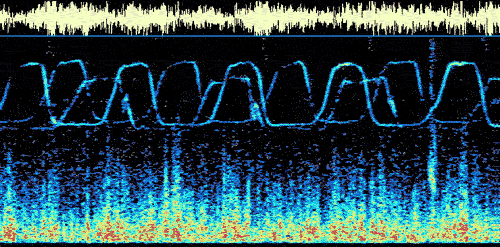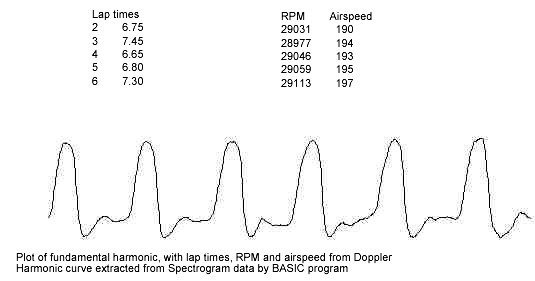| First a word to the
Editors of this fine newsletter. You just keep it coming regularly
on the 3rd of each month, and there won't be any riots! My
goodness, it was tough going without a January edition, I
nearly started listening to the golf! And where was last issues
editorial, I'm still looking for it? How about 2 editorials
this issue to make up!
Now I hope you liked last issues' introduction to Dr. Doppler,
because this is another serve of the same dish, just warmed
over a little, so its going to ramble, on and on, somewhat.
Re-reading that article, I realised I had not really given
enough credit to Konstantin Zeldovitch's Oscilloscpe 2.51.
This program yields not just a virtual oscilloscope, but a
dual channel digital storage oscilloscope with single channel
audio spectrum analyser. For just $30 spent on the sound card
preamp, you will never see value like that again in this life.
Unless of course you download Richard Hornes Spectrogram 4.2.6.5
Huh, why?
Well the truth is I exaggerated somewhat the ease with which
the coming and going frequencies required to get the airspeed
and RPM could be obtained from Oscilloscope 2.51. In fact
it took both Rosemary and myself to have enough fingers to
push all the scope and tape recorder buttons required to get
those numbers. The fact is that the "scope" style of display
is tricky to use. It occurred to me that if the spectra could
all be stored on disc then I may be able to write a BASIC
program that would do that for me; ie, the spectrum analyser
would be more useful if it had a data logger facility.
So I hopped onto the Information Supercool highway and found
Richard Horne's site at http://home.swipnet.se/~w-41522/ There
I downloaded gram4265.zip, a 169K file. What a revelation!
This Spectrogram program was used by radio enthusiasts, so
Richard incorporated a data logger into it. Otherwise he was
using it to get the audio signature of whales, birds and the
like.
So what is a spectrogram? Unlike the "scope" type display
which plots frequency against sound level at one instant in
time, the Spectrogram output is a "scrolling" display.
The display has time on the horizontal axis, frequency on
the vertical, and sound level is represented by a color scale.
This is a revelation. The harmonics we need for Doppler appear
as wavy lines across the screen, so that the peaks and dips
which occur with the model coming and going are laid out as
clearly as a Picasso painting.
All one has to do is to halt the scrolling, place the cursor
on the peaks and dips and read off the frequencies. That leaves
Rosemary free to go back and practise her recorder. One can
also read off the time, so that lap times also may be extracted
from the tape recording.

Furthermore, the data logger feature permits
automatic analysis of these data off-line. I have written
a BASIC program which does this; the results accompany this
text.

We have had some more experience operating
this system now, with some lessons learned.
Some guys in Sydney wanted their pylon racers (F3D) checked
out. So they phoned me from Pitt Town and held up their mobile
phone as the model screamed around. Fifteen minutes later
I phoned them back and gave them their inflight RPM, airspeed
and their lap-times! Pretty neat.
But there were problems. For some of the time, the phone cut
out altogether. It appears that if the sound level goes beneath
a certain threshold, the phone cuts off. This apparently to
reduce background noise in conversations. Otherwise, everything
worked fine. The same guys also played a tape recording over
the phone, which I recorded at this end using an inductive
coupler. The result was a little disappointing with respect
to noise level, but still quite useable. Since then I have
gone to a capacitive coupler, and this works extremely well.
On the C/L side, Bob Fry brought around a tape of his Bendix
with Grant Lucas' speed model in the background. We had some
problems getting the signal strength strong enough. It didn't
help that Bob was in a hurry, but we got there in the end.
It appeared that the Bendix/Nelson model was not showing strong
high order harmonics, so we had to go on the weak fundamental.
The harmonics may have been there, but I did not have time
to hunt for them.
The airspeeds we got were about 8% low compared to a stopwatch.
It transpired that Alasdair had placed the tape recorder on
the ground, close to the circle. This meant that there was
a big angle between the plane of flight and the moments when
the model was approaching and receding from the tape.
This gave a large height correction factor, which one is better
off without. The tape should be held at the same height as
the model. It also helps if the tape is about 20m back from
the edge of the circle, as this places the peaks and troughs
on the Spectrogram further apart.
We also analysed Grants speed model, which was 100m away in
the background. He won't mind me telling you that it was doing
130 MPH at 24000, because it is his Picco 40 monoline trainer
and he is just foxing anyway! But watch him go in NSW at next
years Nats!
That's it from the prop Doctor for this month, so keep on
circulating! |